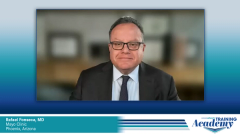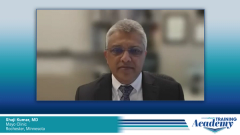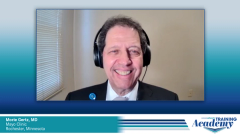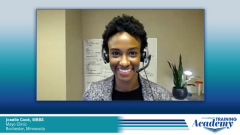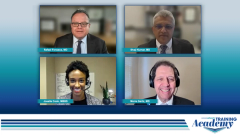
Selecting Patients for BCMA and Non-BCMA Bispecifics in Multiple Myeloma
Expert panelists from Mayo Clinic discuss their approach for the use of BCMA and non-BCMA targeting bispecifics, respectively, in patients with relapsed/refractory multiple myeloma.
Episodes in this series

Transcript:
Rafael Fonseca, MD: We have about 15 minutes remaining. What I’m going to do is ask some rapid-fire styled questions and, if you don’t mind, [give] me a rapid answer. We always wonder about bispecifics. We don’t have ADCs [antibody-drug conjugates]; unfortunately, they’re not available right now. CAR [chimeric antigen receptor] T cells, we talked about how we might sequence them. The reality is I think we’re looking at similar mechanism of actions, and the questions are going to be how good are those T-cells and how good are the targets? One of the possibilities that has been published, which seems to be the minority, is selection of cells without expression of the target. We have to keep an eye on all that; in the future, do we measure this in the cells, and so forth. But again, I promised quick questions. So, Dr Gertz, can you reuse BCMA [B-cell maturation antigen]-targeting bispecifics in patients who have prior CAR T cells that target BCMA?
Morie Gertz, MD: Your question is timed well because this was published in Blood on March 23. It’s kind of hot off the press. They looked at 79 patients who had progression after BCMA-directed [CAR T-cell therapy]. Overall survival after progression on CAR T was 18 months. So that’s pretty serious. Thirty-five patients received T-cell-engaging therapy, bispecific [therapy], or a second CAR T-cell therapy. In those patients, overall survival hadn’t been reached after a median follow-up of 21 months. Using a bispecific after CAR T is an option. I don’t know the answer for bispecific followed by CAR T. I can’t say that. But I’m going to say regarding T-cell exhaustion, I can see a future where I send the patient in for their first-line therapy to get their CD34 apheresed at the time of transplant and, on day 1 of that apheresis, also collecting and cryopreserving T cells at original diagnosis, after 4 cycles of induction therapy. Those T cells can sit. We’re used to having stem cells, CD34 cells, sit years for salvage second transplant. I don’t think there are going to be any major barriers, other than the cryopreservation costs of getting T cells early on before they’ve been hit with 5 lines of therapy, to letting them sit for future manufacture.
Rafael Fonseca, MD: Thank you very much. Dr Kumar, the use of the known BCMA-targeting agents, just general thoughts. What do you think about them?
Shaji Kumar, MD: I think it’s important. The data that we have seen with both talquetamab and cevostamab, which are targeting different antigens, appear to be quite comparable to the BCMA-targeted bispecifics. I think for across the platform and the mechanism of action, the activity appears to be comparable. The question of whether to use a different antigen as the target after a BCMA-targeted agent is what I think we really need to be looking forward to. I suspect that would be the scenario where we might end up using many of these. Also, taking into account specific toxicities associated with that approach might determine whether you use one versus the other in specific patients.
Rafael Fonseca, MD: Thank you. Dr Cook, what are the specific toxicities that our audience should know about [in regard to] those known BCMA-targeting agents? We talked briefly about that before.
Joselle Cook, MBBS: Yes, definitely. I think the big one is what we’re seeing with the GPRC5 [G protein-coupled receptor class C group 5] BCMA drug. Skin changes, nail changes, dry mouth, and dysgeusia are things that significantly affect quality of life for patients that we’ll also have to manage. I would recommend good oral care and hygiene, just as we would for someone who would experience mucositis if they’re undergoing a transplant. For the palmoplantar changes that are seen, ammonium lotions, Aquaphor, Vanicream, and similar heavy creams to keep things moisturized [are] what I would recommend for patients who experience skin, mouth, and nail changes.
Rafael Fonseca, MD: Thank you very much. Dr Gertz, we talked about it briefly, the role of bispecifics in earlier lines of therapy. You were nodding as I was referring to the study … What are your thoughts there?
Morie Gertz, MD: It’s absolutely the nature of every multiple myeloma drug. We start them when patients have no alternatives left, and then we begin to move them up earlier and earlier and earlier in the course. When transplants started it was something for patients who were multiply refractory, and now, of course, it’s part of our first-line therapy. But we did the same thing with lenalidomide and daratumumab. As we saw activity, we started moving it up. Now there are trials that are actually randomizing patient after induction to transplant versus CAR [T-cell] therapy, and I don’t think that bispecifics are going to be any different. I just saw a recent presentation about repeating CAR T. Patients, after receiving therapy, their BCMA levels on the surface are very low, but with time they begin to recover. BCMA levels go up. It’s not naïve to think that a second application of a BCMA-targeting agent could be effective.
Rafael Fonseca, MD: Thank you. It’s just tantalizing to think of what the future will bring. Speaking of things we do in multiple myeloma, [Dr Kumar], we combine things. There are some studies looking at bispecifics and daratumumab in combination. Any comments there?
Shaji Kumar, MD: Yes, so these are the results of the TRIMM-2 trial where they looked at combining a standard dose of daratumumab with an increasing dose of teclistamab. A limited number of patients were studied but the data looked quite interesting because, among this cohort of patients, nearly three-quarters of them had been exposed to daratumumab before. Despite that, the combination you are talking about had a response rate of about 75% and also a VGPR [very good partial response] of about 56%. Clearly, that combination appears to be effective, even in people who have been exposed to all the previous drugs. Now, at the same time, I think there’s a need for a word of caution here because we clearly see an increased risk of infection among these patients. I know this was already talked about in the context of teclistamab, but when you combine that with daratumumab, there’s the risk of a higher rate of infections, particularly serious infections. I think the trial opens up the possibility that they could combine this with other drugs, but at the same time it also begs for more data in terms of toxicity.
Rafael Fonseca, MD: Yes, I think we’ll have to be careful with that to make sure we understand the toxicity. Fortunately, we have clinical trials going on.
Transcript edited for clarity.
Newsletter
Stay up to date on recent advances in the multidisciplinary approach to cancer.


